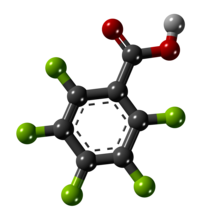Pentafluorobenzoic acid (PFBA) is an organofluorine compound with the formula C6F5CO2H. It is a white crystalline powder that has a high solubility in water. Its pKa of 1.48 indicates that it is a strong acid.[1]

| |

| |
| Names | |
|---|---|
| Preferred IUPAC name
Pentafluorobenzoic acid | |
| Other names
perfluorobenzoic acid
| |
| Identifiers | |
3D model (JSmol)
|
|
| 2054395 | |
| ChemSpider | |
| ECHA InfoCard | 100.009.115 |
| 2054395 | |
PubChem CID
|
|
| UNII | |
CompTox Dashboard (EPA)
|
|
| |
| |
| Properties | |
| C7HF5O2 | |
| Molar mass | 212.075 g·mol−1 |
| Appearance | White crystalline powder |
| Density | 1.942 g/cm3 |
| Melting point | 100–102 °C (212–216 °F; 373–375 K) |
| Boiling point | 220 °C (428 °F; 493 K) |
| Very soluble | |
| log P | 2.06 |
| Acidity (pKa) | 1.60 |
| Hazards | |
| NFPA 704 (fire diamond) | |
| Flash point | 87 °C (189 °F; 360 K) |
| Related compounds | |
Related carboxylic acids
|
benzoic acids, Nitrobenzoic acids |
Except where otherwise noted, data are given for materials in their standard state (at 25 °C [77 °F], 100 kPa).
| |
Preparation edit
Pentafluorobenzoic acid is prepared by treating pentafluorophenyllithium (or pentafluorophenyl Grignard reagent) with carbon dioxide. These reagents are usually prepared in situ from pentafluorobenzene and bromopentafluorobenzene.[1][2]
It arises via the reaction of perfluorotoluene with trifluoroacetic acid and antimony pentafluoride.[3]
Substitution reactions edit
Substitution of fluoride occurs typically at the para position. This reaction has been used to anchor the −C6F4CO2H group to surfaces. Magnesium methoxide results in ortho methoxylation. Cleavage of this ether gives tetrafluorosalicylic acid. Via similar ortho-directed reactivity, nickel complexes catalyse the defluoridation of 2 and 5 positions. Without nickel, defluoridation occurs with para-selectivity.[1]
References edit
- ^ a b c Prakash, G. K. S.; Hu, J. "Pentafluorobenzoic Acid" in e-EROS Encyclopedia of Reagents for Organic Synthesis, 2005. doi:10.1002/047084289X.rn00682
- ^ Harper, R. J. Jr.; Soloski, E. J.; Tamborski, C. (1964). "Reactions of Organometallics with Fluoroaromatic Compounds". J. Org. Chem. 29 (8): 2385. doi:10.1021/jo01031a067.
- ^ Zonov, Yaroslav V.; Karpov, Victor M.; Platonov, Vyacheslav E. (2007). "Transformation of perfluorinated benzocycloalkenes and alkylbenzenes to their carbonyl derivatives under the action of CF3COOH/SbF5". Journal of Fluorine Chemistry. 128 (9): 1058–1064. doi:10.1016/j.jfluchem.2007.05.020.
